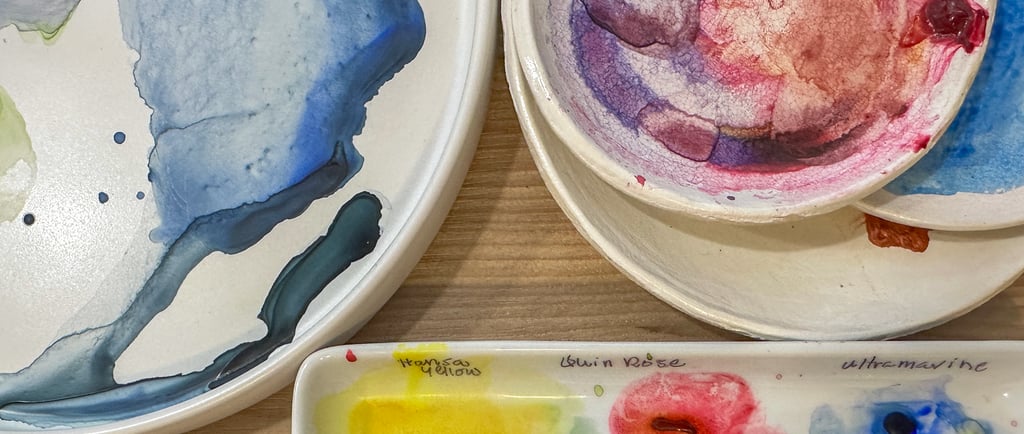Free standard shipping on orders over $49
Beginner’s Guide to Watercolor Supplies: What to Buy (and What to Skip)
A practical guide to watercolor paints, brushes, and paper, plus how to avoid the pricey tools that just collect dust
TOOLS & SUPPLIES
5/8/20243 min read


*We may receive commissions from any links you click.
When I first started painting with watercolor, I was overwhelmed. I bought paints that turned out to be the wrong kind, brushes that were terrible, and paper that didn’t work at all. The list goes on.
I spent too much money on supplies that ended up barely used because I quickly learned I needed something different. You don’t need the fanciest or most expensive tools, but you do want supplies you’ll actually use. Here’s a quick guide to what you need, where you can save, and where you should splurge.
Watercolor Paints
Here is a lesson I wish I had learned sooner: start with a small set. Six colors, which means the primary colors in both cool and warm tones, is plenty (though in some brands, a 12-color set might be easier to find). With a limited palette, you will learn how to mix colors, what works together, and how your paints behave.
You have two main options:
Pan paints: Dried paints that you activate with water.
Tube paints: Wet paints squeezed from a tube.
Both work well, so it comes down to personal preference.
For beginners, I recommend student-grade paints such as Winsor & Newton Cotman, Grabie, or Meeden. They are affordable, easy to work with, and have good color. Avoid very cheap “kids” sets because they have weak pigment and can be frustrating. I started with Grabie and Cotman, and I still use both.
Quick Tip: Start with six colors if you can find a smaller palette to focus on learning color mixing before you expand your palette.
Brushes
You will see tutorials using every brush shape imaginable. Do not feel like you need to collect them all right away. That approach usually ends with a jar full of brushes you never touch.
Start with a small set of round synthetic brushes in sizes 2 through 8. This range covers fine details and larger washes. I recommend synthetic brushes such as Princeton Aqua Elite (synthetic Kolinsky hair that comes to a sharp point) or Fuumuui sets (slightly softer point, which some beginners find easier).
Avoid bargain-bin sets of 20 brushes from the craft store. They rarely hold water well and can make painting harder than it needs to be. If you can only get a few, start with a size 2 or 3, a size 6, and, if possible, a size 8.
It is also helpful to have a flat wash brush for laying in large areas of water or color.
Save Here: Skip the giant multi-pack brush sets. Spend on 3 or 4 quality brushes you will use often.
Paper
This is the one supply where I suggest spending more. In watercolor, paper quality affects how the paint looks, how the water behaves, and whether the paper buckles.
Look for paper that is:
100 percent cotton
140 lb / 300 GSM
Cold press (slightly textured)
Good beginner options include Meeden 100 percent Cotton, Academy Paper (by Baohong), or Grabie cotton paper. Arches is a professional favorite with excellent quality, but it is also expensive.
Avoid printer paper, cardstock, or anything not made for watercolor. Non-cotton watercolor paper can work in a pinch, but it often dries unpredictably and struggles with heavy water use.
Splurge Here: Cotton paper will make learning easier and your results more satisfying.
The Rest of the Things
Paint, brushes, and paper are the big three, but you will also need:
Water containers: Two jars or cups, one for rinsing and one for clean water.
Palette or mixing surface: White ceramic plates are my favorite for accurate color mixing. White coated paper plates work too.
Pencil and eraser: An HB or 2H pencil with a kneaded or silicone eraser for light sketching. Avoid soft lead pencils since they can smear and muddy your colors.
Paper towels or a cloth: For blotting water or lifting paint. You will use these constantly.
Masking tape: To tape down your paper and reduce buckling. Washi tape works too.
Quick Tip: Most of these extra items can be found around your house, so do not feel like you need to buy everything new.
Getting Started for Less
You can get everything you need, including paints, brushes, and paper, for about $60 to $90:
Brushes: $30 to $40
Paints: $20 to $30
Paper: $10 to $20
Start small, learn with the basics, and upgrade as you go. This approach will help you figure out what you like, what you do not, and what is worth investing in as you grow in watercolor.
Final Tip: The best supplies are the ones you will actually use. Start with tools that make you excited to sit down and paint.